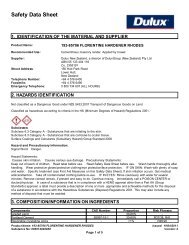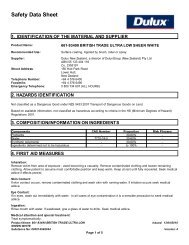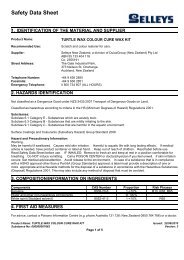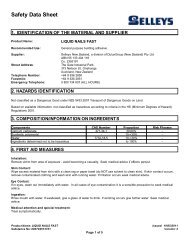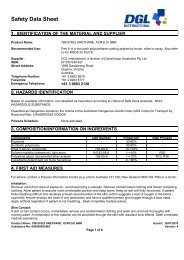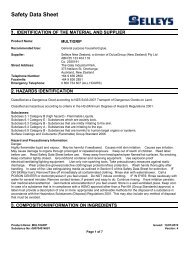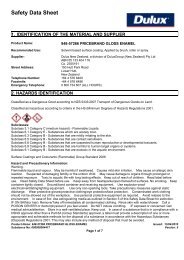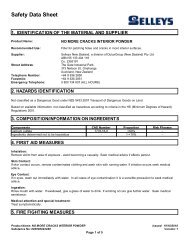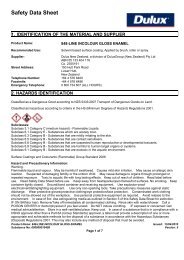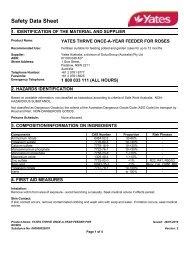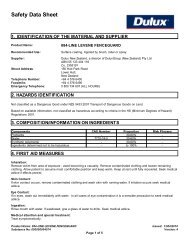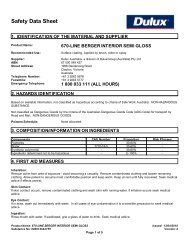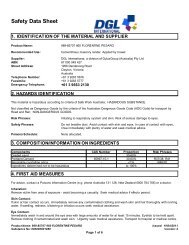parfix gap filler - MSDS
parfix gap filler - MSDS
parfix gap filler - MSDS
Create successful ePaper yourself
Turn your PDF publications into a flip-book with our unique Google optimized e-Paper software.
Safety Data Sheet<br />
1. IDENTIFICATION OF THE MATERIAL AND SUPPLIER<br />
Product Name: PARFIX GAP FILLER<br />
Recommended use of the chemical<br />
and restrictions on use:<br />
Supplier: DuluxGroup (Australia) Pty Ltd<br />
ABN: 67 000 049 427<br />
Street Address: 1 Gow Street,<br />
Padstow, NSW 2211<br />
Australia<br />
Telephone Number: 1300 132 082<br />
Facsimile: 1300 555 305<br />
Emergency Telephone: 1 800 033 111 (ALL HOURS)<br />
2. HAZARDS IDENTIFICATION<br />
Flexible acrylic sealant for interior/exterior use in joints, <strong>gap</strong>s or cracks in most building<br />
situations.<br />
Not classified as Dangerous Goods by the criteria of the Australian Dangerous Goods Code (ADG Code) for transport by<br />
Road and Rail; NON-DANGEROUS GOODS.<br />
Based on available information, not classified as hazardous according to Safe Work Australia; NON-HAZARDOUS SUBSTANCE.<br />
Poisons Schedule (SUSMP): None allocated.<br />
3. COMPOSITION/INFORMATION ON INGREDIENTS<br />
Components CAS Number Proportion Risk Phrases<br />
Pigments and <strong>filler</strong>s - 30-60% -<br />
Synthetic polymer(s) - 10-
Safety Data Sheet<br />
5. FIRE FIGHTING MEASURES<br />
Suitable Extinguishing Media:<br />
Not combustible, however, if material is involved in a fire use: Fine water spray, normal foam, dry agent (carbon dioxide, dry<br />
chemical powder).<br />
Specific hazards arising from the substance or mixture:<br />
Not combustible, however following evaporation of the water component of the material, the residual material can burn if<br />
ignited. On burning will emit toxic fumes.<br />
Special protective equipment and precautions for fire-fighters:<br />
Fire fighters to wear self-contained breathing apparatus and suitable protective clothing if risk of exposure to vapour or<br />
products of combustion.<br />
6. ACCIDENTAL RELEASE MEASURES<br />
Emergency procedures/Environmental precautions:<br />
If contamination of sewers or waterways has occurred advise local emergency services.<br />
Personal precautions/Protective equipment/Methods and materials for containment and cleaning up:<br />
SMALL SPILLS: Wipe up with absorbent (clean rag or paper towels). Allow absorbent to dry before disposing with normal<br />
household garbage.<br />
LARGE SPILLS: Slippery when spilt. Avoid accidents, clean up immediately. Wear protective equipment to prevent skin<br />
and eye contact. Contain - prevent run off into drains and waterways. Use absorbent (soil, sand or other inert material).<br />
Collect and seal in properly labelled containers or drums for disposal. Wash area down with excess water. Cured material<br />
can only be removed by cutting or abrasion.<br />
7. HANDLING AND STORAGE<br />
Precautions for safe handling:<br />
Keep out of reach of children. Avoid eye contact and repeated or prolonged skin contact.<br />
Conditions for safe storage, including any incompatibilities:<br />
Store in cool place and out of direct sunlight. Store away from incompatible materials described in Section 10. Protect from<br />
freezing. Keep containers closed when not in use - check regularly for leaks.<br />
8. EXPOSURE CONTROLS/PERSONAL PROTECTION<br />
Control Parameters: No value assigned for this specific material by Safe Work Australia. However, Workplace Exposure<br />
Standard(s) for constituent(s):<br />
White spirits: 8hr TWA = 790 mg/m3<br />
As published by Safe Work Australia Workplace Exposure Standards for Airborne Contaminants.<br />
TWA - The time-weighted average airborne concentration of a particular substance when calculated over an eight-hour<br />
working day, for a five-day working week.<br />
These Workplace Exposure Standards are guides to be used in the control of occupational health hazards. All atmospheric<br />
contamination should be kept to as low a level as is workable. These workplace exposure standards should not be used as<br />
fine dividing lines between safe and dangerous concentrations of chemicals. They are not a measure of relative toxicity.<br />
Product Name: PARFIX GAP FILLER Issued: 25/03/2013<br />
Substance No: 000000020101 Version: 4<br />
Page 2 of 5
Safety Data Sheet<br />
Appropriate engineering controls:<br />
Natural ventilation should be adequate under normal use conditions. Keep containers closed when not in use.<br />
Individual protection measures, such as Personal Protective Equipment (PPE):<br />
The selection of PPE is dependant on a detailed risk assessment. The risk assessment should consider the work situation,<br />
the physical form of the chemical, the handling methods, and environmental factors.<br />
OVERALLS, SAFETY SHOES, SAFETY GLASSES, GLOVES.<br />
MANUFACTURE, PACKAGING AND TRANSPORT: Wear overalls, safety glasses and impervious gloves. Always wash<br />
hands before smoking, eating, drinking or using the toilet. Wash contaminated clothing and other protective equipment before<br />
storage or re-use.<br />
FOR CONSUMER USE: No special personal protective equipment required. Wash hands after use. Rubber gloves are<br />
recommended if handling often.<br />
9. PHYSICAL AND CHEMICAL PROPERTIES<br />
Physical state: Paste<br />
Colour: White<br />
Odour: Slight<br />
Solubility: Dispersible in water.<br />
Specific Gravity: 1.6<br />
Relative Vapour Density (air=1): Not available<br />
Vapour Pressure (20 °C): Not available<br />
Flash Point (°C): Not applicable<br />
Flammability Limits (%): Not applicable<br />
Autoignition Temperature (°C): Not applicable<br />
% Volatile by Weight: 20<br />
Solubility in water (g/L): Dispersible<br />
Melting Point/Range (°C): Not applicable<br />
Boiling Point/Range (°C): 100 (water)<br />
Decomposition Point (°C): Not available<br />
pH: Not available<br />
Viscosity: Not available<br />
Evaporation Rate: Not available<br />
10. STABILITY AND REACTIVITY<br />
Reactivity: No information available.<br />
Chemical stability: Stable under normal conditions of use.<br />
Possibility of hazardous reactions: Reacts with acids liberating carbon dioxide . Hazardous polymerisation will not occur.<br />
Conditions to avoid: Avoid exposure to direct sunlight. Avoid exposure to frost.<br />
Incompatible materials: Incompatible with oxidising agents.<br />
Product Name: PARFIX GAP FILLER Issued: 25/03/2013<br />
Substance No: 000000020101 Version: 4<br />
Page 3 of 5
Safety Data Sheet<br />
Hazardous decomposition<br />
products:<br />
Oxides of carbon.<br />
11. TOXICOLOGICAL INFORMATION<br />
No adverse health effects expected if the product is handled in accordance with this Safety Data Sheet and the product<br />
label. Symptoms or effects that may arise if the product is mishandled and overexposure occurs are:<br />
Ingestion: No adverse effects expected, however, large amounts may cause nausea and vomiting.<br />
Swallowing calcium carbonate can result in the generation of uncomfortable quantities<br />
of carbon dioxide gas in the stomach.<br />
Eye contact: May be an eye irritant.<br />
Skin contact: Repeated or prolonged skin contact may lead to irritation.<br />
Inhalation: Not expected to cause respiratory irritation.<br />
Acute toxicity: No LD50 data available for the product.<br />
Chronic effects: No information available for the product.<br />
12. ECOLOGICAL INFORMATION<br />
Ecotoxicity Avoid contaminating waterways.<br />
13. DISPOSAL CONSIDERATIONS<br />
Disposal methods:<br />
Refer to Waste Management Authority. Dispose of material through a licensed waste contractor. Normally suitable for<br />
disposal at approved land waste site.<br />
14. TRANSPORT INFORMATION<br />
Road and Rail Transport<br />
Not classified as Dangerous Goods by the criteria of the Australian Dangerous Goods Code (ADG Code) for transport by<br />
Road and Rail; NON-DANGEROUS GOODS.<br />
Marine Transport<br />
Not classified as Dangerous Goods by the criteria of the International Maritime Dangerous Goods Code (IMDG Code) for<br />
transport by sea; NON-DANGEROUS GOODS.<br />
Air Transport<br />
Not classified as Dangerous Goods by the criteria of the International Air Transport Association (IATA) Dangerous Goods<br />
Regulations for transport by air; NON-DANGEROUS GOODS.<br />
15. REGULATORY INFORMATION<br />
Classification:<br />
Based on available information, not classified as hazardous according to Safe Work Australia; NON-HAZARDOUS SUBSTANCE.<br />
Poisons Schedule (SUSMP): None allocated.<br />
All the constituents of this material are listed on the Australian Inventory of Chemical Substances (AICS).<br />
Product Name: PARFIX GAP FILLER Issued: 25/03/2013<br />
Substance No: 000000020101 Version: 4<br />
Page 4 of 5
Safety Data Sheet<br />
16. OTHER INFORMATION<br />
Reason(s) for Issue:<br />
Revised Primary SDS<br />
This safety data sheet has been prepared by SDS Services.<br />
This SDS summarises to our best knowledge at the date of issue, the chemical health and safety hazards of the material<br />
and general guidance on how to safely handle the material in the workplace. Since DuluxGroup Limited cannot anticipate or<br />
control the conditions under which the product may be used, each user must, prior to usage, assess and control the risks<br />
arising from its use of the material.<br />
If clarification or further information is needed, the user should contact their DuluxGroup representative or DuluxGroup Limited<br />
at the contact details on page 1.<br />
DuluxGroup Limited's responsibility for the material as sold is subject to the terms and conditions of sale, a copy of which is<br />
available upon request.<br />
Product Name: PARFIX GAP FILLER Issued: 25/03/2013<br />
Substance No: 000000020101 Version: 4<br />
Page 5 of 5




